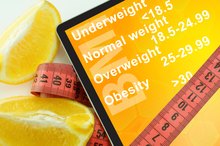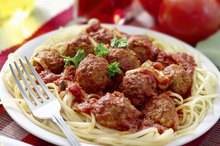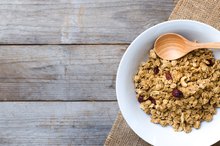Increasing your caloric intake helps you gain weight. To help you put on quality pounds in the form of lean muscle, make the calories come from healthy sources. If you're underweight because of injury, surgery or illness, adding nutrient-rich calories will help you heal 7. Even if you simply want to look healthier and feel more energetic, having a balanced meal plan, along with engaging in appropriate exercise, will help you reach your goals.
Healthy Overview of an Increased Calorie Diet
Dairy, such as:
- brown rice
- quinoa
- further boost your calorie intake in nutritious ways
Increase Calories at Meal Time
High Calorie Non-Dairy Foods
Learn More
An obvious way to increase calories at meals is to increase your portion sizes. For example, to add 216 calories, have 2 cups of brown rice instead of 1 cup at lunch.
Cook 1/2 cup instead of 1/3 cup of dry oats for cereal or add an extra egg to your omelet for a bigger breakfast. Consider your choices at meals, too, and go for the more calorie-dense option when possible. Choose a sandwich on a large whole-grain roll rather than on flat bread or opt for chili instead of a broth-based soup. These minor increases in portion size and changes in choice add up and result in a net addition of 250 to 500 calories per day -- enough to gain 1/2 to 1 pound per week.
- An obvious way to increase calories at meals is to increase your portion sizes.
- These minor increases in portion size and changes in choice add up and result in a net addition of 250 to 500 calories per day -- enough to gain 1/2 to 1 pound per week.
Calorie Additions Without Increasing Portions
If you're maxed out on food intake and you don't have the appetite for larger servings, make small additions to existing meals to boost the calorie intake. For example, cook hot cereal in milk instead of water, sprinkle extra shredded cheese over eggs or add sunflower seeds to a salad.
These small additions also add up calorie-wise. Avocado on a salad or sandwich, walnuts in cereal, cashews in a stir-fry and peanut butter on an apple are other ways to raise caloric intake with small additions of food that won't fill you up too much.
- If you're maxed out on food intake and you don't have the appetite for larger servings, make small additions to existing meals to boost the calorie intake.
- Avocado on a salad or sandwich, walnuts in cereal, cashews in a stir-fry and peanut butter on an apple are other ways to raise caloric intake with small additions of food that won't fill you up too much.
Make Snacks Count, Calorically
How to Use Lean Cuisine in Place of NutriSystem
Learn More
Plan on having three meals and three snacks if possible, every two to four hours. A missed meal or snack is a missed opportunity to increase your caloric intake. Have one snack between breakfast and lunch, one between lunch and dinner and one before bed.
Grabbing a piece of low-fat string cheese or a handful of grapes isn't going to be enough to notably boost your caloric intake. Choose 1/2 cup of nuts for 400 calories, a sandwich on whole-wheat bread with 2 tablespoons of peanut butter for 350 calories or 1 cup of granola in milk for 550 calories. Dried fruit, a smoothie made with pineapple, yogurt and hummus with whole-grain pita are other calorically dense choices. Instead of snacking at regular intervals, you could also graze all day on nuts, dried fruit or pretzels.
Drinking your calories also counts toward your overall caloric intake. Choose nutritious drinks such as milk or 100 percent fruit juice for 100 to 150 calories per 8 ounces. Limit your juice consumption, however, as it contains quite a bit of sugar.
- Plan on having three meals and three snacks if possible, every two to four hours.
- Instead of snacking at regular intervals, you could also graze all day on nuts, dried fruit or pretzels.
Related Articles
References
- Academy of Nutrition and Dietetics: Healthy Weight Gain
- CNN: How Should I Eat to Build Muscle Mass?
- Today's Dietitian: Underweight: A Heavy Concern
- HealthAliciousNess: Brown Rice, Potatoes, Steak
- HealthAliciousNess: Oil, Dates, Dry Milk
- NHS: Underweight Teen Boys
- American Heart Association. Saturated Fat.
- Hall KD, Sacks G, Chandramohan D, et al. Quantification of the effect of energy imbalance on bodyweight. Lancet. 2011;378(9793):826–837. doi:10.1016/S0140-6736(11)60812-X
- Merck Manual. Carbohydrates, Proteins, and Fats.
- U.S. Department of Agriculture, Agricultural Research Service. FoodData Central.
- Academy of Nutrition and Dietetics. Choose Healthy Fats.
Writer Bio
Andrea Cespedes is a professionally trained chef who has focused studies in nutrition. With more than 20 years of experience in the fitness industry, she coaches cycling and running and teaches Pilates and yoga. She is an American Council on Exercise-certified personal trainer, RYT-200 and has degrees from Princeton and Columbia University.








